“You know that these two nations are at war over a few acres of snow near Canada, and that they are spending on this little war more than all of Canada is worth.” ( Voltaire,Candide)
“A few acres of snow” (in the original French, “Quelques arpents de neige”) is a quotation from Voltaire popularly understood to be a sneering evaluation of New France’s — and, by extension, Canada’s — lack of mercantile value and strategic importance to France. It is regularly quoted by Canadians and particularly Quebecers who want to prove that Canada is worth much more than Voltaire’s dismissive perception.
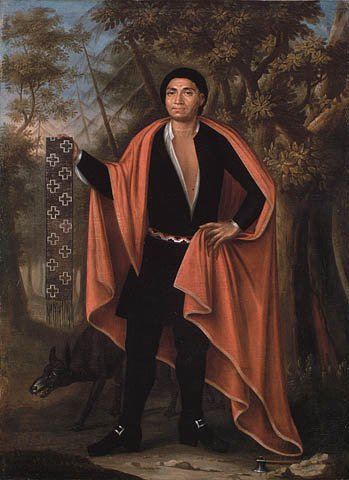
"This is the first time that natives were painted this way,” Hall says. “This is the first time the First Nations representatives have been displayed in this stance, the way they would have portrayed British nobility or gentleman in the past. From a portraiture point of view, they are quite important.”
“For example, buoyed by the perverse principle of collective guilt for posterity, native readers informed me that my ancestors were land thieves, as was I. Who cares that my people have an alibi? At the time of the crimes against natives they were being persecuted in Europe for being Jews. No matter: according to orthodoxy, all Eurocentric folk stand in the dock accused (falsely) of stealing the land from natives, who, of course, had only ever lived in harmony with it.
Natives are nature’s custodians; there’s another fallacy popularized by Jean-Jacques Rousseau’s panegyric on the Noble Savage. Voltaire was in the know when he said that Rousseau is to philosophers as the ape is to man. Rousseau certainly was uninformed by facts when he described natives as living in unity with nature. Less forgivable are the many present-day authors and researchers who, despite the corpus of research attesting to the lack of conservation among natives, persist in describing pre-Columbian America as “a pristine natural kingdom”. ( Ilana Mercer )
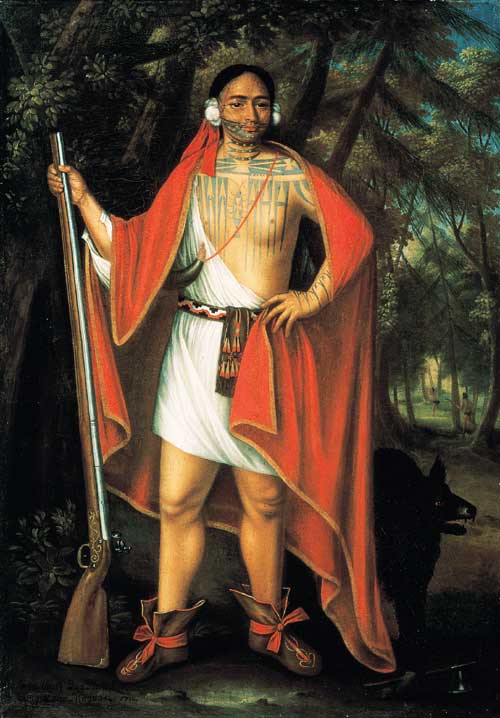
The portraiture style of the Verelst pieces was normally reserved for nobility, which made the paintings historic.
One is also reminded of Thomas Keefer’s lament that “from Canada there is no escape; blockaded and imprisoned by ice and apathy.” A partial explanation for the varying opinions may be that Canadian winters meant different things to different people. According to Judith Fingard, “to the successful merchant and his family, winter represented a time of entertainment, sport, cultural activity, or a worst, boredom. ” While to the laborer winter was ” synonymous with hardship, cold, hunger, and gloomy unemployment or underemployment. Too many, there was great disappointment that the high expectations of a promise of a better life was illusionary…
“The Four Indian Kings” was a series of paintings by Verelst, considered to be profoundly important artifacts of Canadian history and art, are orphan paintings; though owned by Canada through the National Portrait Gallery. With no physical home of its own, they sit in mothballs, dusted off from time to time for temporary showings. They were painted in 1710 by a Dutch painter named John Verelst and are highly European representations that reflected the popular myths of the time. How did this myth arise, and was it basically the same ideology as its outright racist version that developed later?
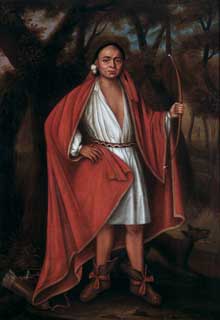
"Born in present-day upstate New York, Ho Nee Yeath Taw No Row (baptized John) was one of the Haudenosaunee (Iroquois) known as the "Four Indian Kings." The display of symbolic skin markings, distinctive clothing, and beautiful or unique items were all ways that Native diplomats demonstrated their values and status. There is much discussion among ethnographers regarding the authenticity of the items represented in these paintings. For example, Ho Nee Yeath Taw No Row is depicted holding a bow that would be too small to have been used by an adult. "
Unlike early explorers who had limited contact with North America and its inhabitants, French missionaries, soldiers and administrators spent long periods observing and commenting upon the culture of local native groups and recording the words spoken by indian natives. But, can two wildly different cultures accurately perceive and interpret one another? Early French records portrayed native North Americans as “Noble Savages” from whom Europeans could learn much, but who could learn even more from Europeans; particularly about Catholicism and civilization.
Some adherents of this interpretation even stressed the noble pre-fix and elevated native culture above French. By the early eighteenth-century writer like Baron Lahontan, for example, transformed the Huron from a people who tortured and sometime ate their captives to “children of nature” and “noble savages” who lived in a blissful state of natural grace and harmony, unencumbered by the stultifying trappings of French culture. The romanticized, even utopic view held by, and promoted through Rousseau and later Chateaubriand, was as equally illogical and unrealistic as the changing historical description evolved over the course of the Indian Wars: The “noble savage” imagery slowly transformed into pejorative depictio
f a people who were ruthless heathens, blood thirsty pagans, and not noble in the least.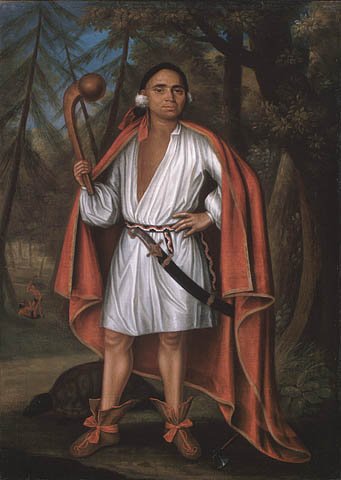
"Verelst depicted the four representatives of the Haudenosaunee (Iroquois) alliance in a style reserved for royalty. Each full-length figure is posed in a stance associated with those wielding power, their gaze directed at the viewer. Mahican Etow Oh Koam (baptized Nicholas) wears or holds items that refer to his status, such as the carved wooden ball-headed club which identifies him as a warrior."
However, truth be said, Rousseau’s summary of the contrast between natural and social existence eloquently attests to the underlying, Eurocentric valorization of European civilization in the critical version of the noble savage myth: “Although, in this state [civil society], he deprives himself of some advantages which he got from nature, he gains in return others so great, his faculties are so stimulated and developed, his ideas so extended, his feelings so ennobled, and his whole soul so uplifted, that, did not the abuses of this new condition often degrade him below that which he left, he would be bound to bless continually the happy moment which took him from it for ever, and, instead of a stupid and unimaginative animal, made him an intelligent being and a man” (The Social Contract)
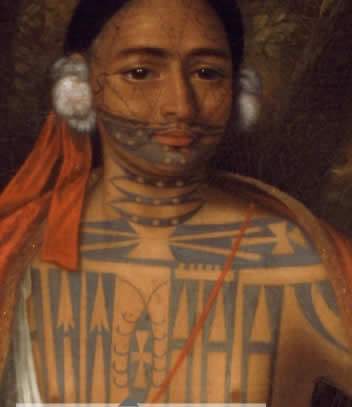
"Although tattoo artists see paintings of the four ‘kings’ as accurate accounts of the tattoos of these individuals, this viewpoint must be approached with caution. While the artist John Verelst most likely painted the faces of the four chiefs from life, their bodies and the background of the paintings may have been added later by the assistants in his workshop.7 It must also be taken into consideration as has been mentioned by members of the Mohawk community, that during this period the European interests were very much about eroticizing the ‘other’"
Verelst’s portraits reflected and ignited the British imagination on the sense of empire; the huge opportunity that colonialism presented and its far reaching consequences particularly with people who had political power in far reaches of the world, and who wanted to have alliances with Britain. The “four Indian kings of Canada,” as they’re popularly known, were not kings, and were not really Canadian. They were delegates sent to London by chiefs of the Iroquois Confederacy, and were from lands along the current Canada-U.S. border in what is now New York.
The men were sent by their Mohawk and Mohican chiefs to the court of Queen Anne, where the royal personage was sufficiently taken with her guests to have them immortalized by Verelst. The Dutchmen did something with his four subjects that both made history and recorded it, from a European perspective.
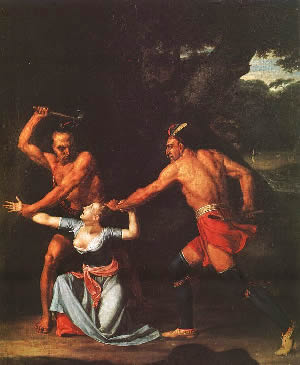
"On February 10, 1676, a Wampanoag party attacked Mary Rowlandson’s town, Lancaster, Massachusetts (30 miles west of Boston). As a result, Mary was taken captive. Her captivity narrative narrates her 20 removes (marching from one location to another). These removes took her on a journey of 150 miles, until she was ransomed for 20 pounds on May 2, 1676. She saw the death of her daughter and other relatives and friends."
From the fifteenth through the nineteenth centuries, the concept of the Noble Savage became a popular element in literature. Columbus wrote of a people who were generous, gentle, had physical beauty, and had minds open to being trained. Voyagers and travel writers for over two centuries proclaimed the “natural goodness of the savages of America and the islands of the south seas.” Many of these travel writers commented on the natural virtues possessed by these Noble Savages, and based on what they observed, raised doubts as to the value of civilization. Many scholars credit Jean-Jacques Rousseau as the primary figure in the history of the Noble Savage concept. According to Rousseau, “the noble savage is an individual living in a ‘pure state of nature’—gentle, wise, uncorrupted by the vices of civilization.” Although the idea of the Noble Savage existed long before Rousseau, he is generally credited with formalizing the concept, or at least romanticizing it into a broader cultural acceptance, almost as a fetish object.
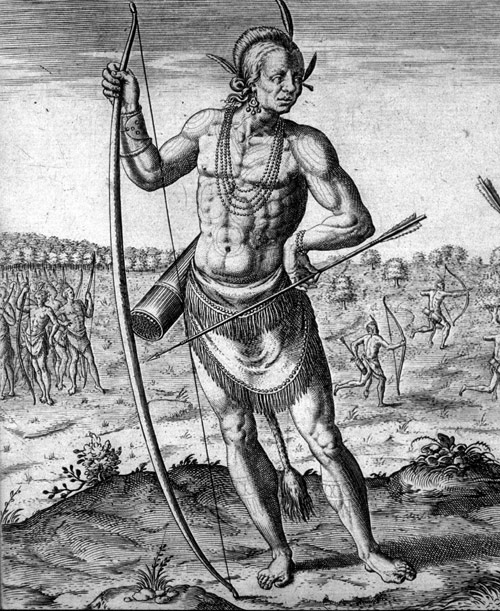
"engraved by Thomas de Bry in 1590 and was based on a drawing by John Smith in 1588. Titled "A Werowan or Great Lord of Virginia," the portrait shows a Powhatan Indian holding a bow and arrow used for hunting and protection. His clothing and accessories are typical of pre-European contact Native American culture. "
Commentary on the idea of the Noble Savage in literature has covered a wide range of topics and perspectives, but each one appears contrived and deeply flawed. As to the origin of the concept, Ter Ellingson claims that there are still unanswered questions, and concluded, “that Rousseau’s invention of the Noble Savage myth is itself a myth.” Stelio Cro argued that Rosseau loved the idea of the Noble Savage because he saw him as a figure of freedom: “physical freedom as opposed to slavery and tyranny, moral freedom as opposed to religious discrimination or superstition.” According to critic Hoxie N. Fairchild, the Noble Savage is really a creation of philosophers who read into explorers’ narratives a concept that would support their disillusionment with civilized society.
In examining travel writers, Lewis Saum argues that fur-trade literature shows a concern on the part of the fur traders that the Noble Savage was being corrupted by the encroaching civilization. Terry Jay Ellingson disagrees, claiming that many travel writings depict natives in a very negative light and that these works should be “taken into account if only for the sake of balance, to counteract the tendency built up over a century and a half of unquestioning acceptance of the myth of the Noble Savage.” Roy Pearce argues that the Noble Savage was a literary invention used for the purpose of creating a history and a culture in America, but one “in which the idea of savagism … compromised the idea of the noble savage and then absorbed and reconstituted it.” Hence, he argues, in the ideology and belief reflected in the literature of the time, natives transformed and became what Americans needed as the country grew. Ironically, the depiction in literature of the Amerindians as Noble Savages was indeed a myth, according to critic Olive Patricia Dickason, who claims that they were “far from being uninformed savages in the ‘infancy of nature,’ [but] were the products of cultures that had evolved over many centuries.”
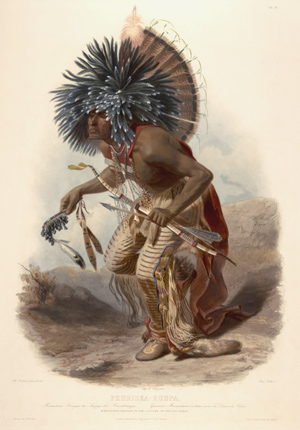
"Moenntarri Warrior in the costume of the dog danse". Wied, Maximilian, Prinz von. Travels in the interior of North America during the years 1832-1834; illustrations by Karl Bodmer.
…Verelst painted the “four kings” in oils, and portrayed them in proud, full-body stance, their favoured weapons in hand and set against a romantic, largely fictional background. All of this was typical in portraiture of the time — if you were in the upper classes of society. This is the first time that natives were painted this way, displayed in the stance, and the pose of the British aristocracy or landed gentry. From a portraiture point of view, they are quite unique. ….
Before the decimation of the native population, largely via the white man’s diseases, the Americas had a sizable population of natives that exerted a considerable ecological footprint. For one, native tribes engaged in bi-annual forest burning. According to an article in “Environment” by B.L. Turner and Karl Butzer “the forests of the Americas, from Canada to Argentina were so highly disturbed or modified by Amerindian use by 1492 that it is surprising that even the popular literature missed this point.” “The species which the Indians most wanted to hunt…were found most easily in areas of recently burnt forest, which is why they burnt the forest over and over again.”

Jamestown Massacre "By May of the next year, Opechancanough asked for a truce to negotiate. The English, who agreed to the meeting, then decided to attempt to end the hostilities – in their own way. When the two sides met to talk, the English offered the Powhatans wine for a friendship toast. Unfortunately, the wine was poisoned, and some 200 Indians died on the spot. Fifty others were dispatched by the English with weapons. Despite this, Chief Opechancanough escaped back to his people. No real resolution took place until twenty-two years later, when a Second Anglo-Powhatan War took place."
Then there was the stampeding during a hunt of herds of animals over a cliff. Used repeatedly, some buffalo jumps hold the remains of hundreds of thousands of animals, with patterns of local extinction being documented. Where agriculture was practiced in the central and southern parts of America, evidence from sediment points to severe soil erosion, which was already widespread before the arrival of the white man.
And who penned the famous words “the flowers are our sisters…the eagle our brother…Whatever we do to the earth, we do to ourselves…”? Chief Seattle’s famous 1854 New Age speech, deployed by environmentalists to buttress native conservationism, was written in 1972 by a Hollywood scriptwriter by the name of Ted Perry.

Benjamin West. "Indeed, you can’t find a homeschooling discussion group these days that does not include a number of excitable contributors who, after reading James Loewen or Howard Zinn, believe they have discovered that America’s past is not fundamentally an exceptional and heroic odyssey, but rather a set of horror stories that has been suppressed by the victors. The truth, as most critics will confess, is complex, and a proper appreciation of that truth comes from an extended study of many authorities, including traditional ones."
In light of archeological findings, the myth of the purity of primitive life juxtaposed to the savagery of Western Culture is even less justified. The Americas are scattered with archeological evidence of routine massacres, cannibalism, dismemberment, slavery, abuse of women and human sacrifice among native tribes. Why, the Northwest Territories Yellowknife tribe eventually disappeared as a direct result of a massacre carried out as late as 1823. By the same shift of logic, should remaining native “nations” perhaps not be made to pay reparations among themselves?
In no way do these facts mitigate or excuse the cruel treatment natives have endured. All they do is cut through the “rhetoric of moral superiority” and challenge the cultural script. ( Ilana Mercer )
“We are a spirit, we are a natural part of the earth, and all of our ancestors, all of our relations who have gone to the spirit world, they are here with us. That’s power. They will help us. They will help us to see if we are willing to look. We are not separated from them because there’s no place to go — we stay here. This is our place: the earth. This is our mother: we will not go away from our mother.
“And no matter what they ever do to us, no matter how they ever strike at us, we must never become reactionary. The one thing that has always bothered me about revolution, every time I have seen the revolutionary, is they have reacted out of hatred for the oppressor. We must do this for the love of our people.
No matter what they ever do to us, we must always act for the love of our people and the earth. We must not react out of hatred against those who have no sense.” – Trudell
Black Hills Survival gathering, 1980





 COMMENTS
COMMENTS